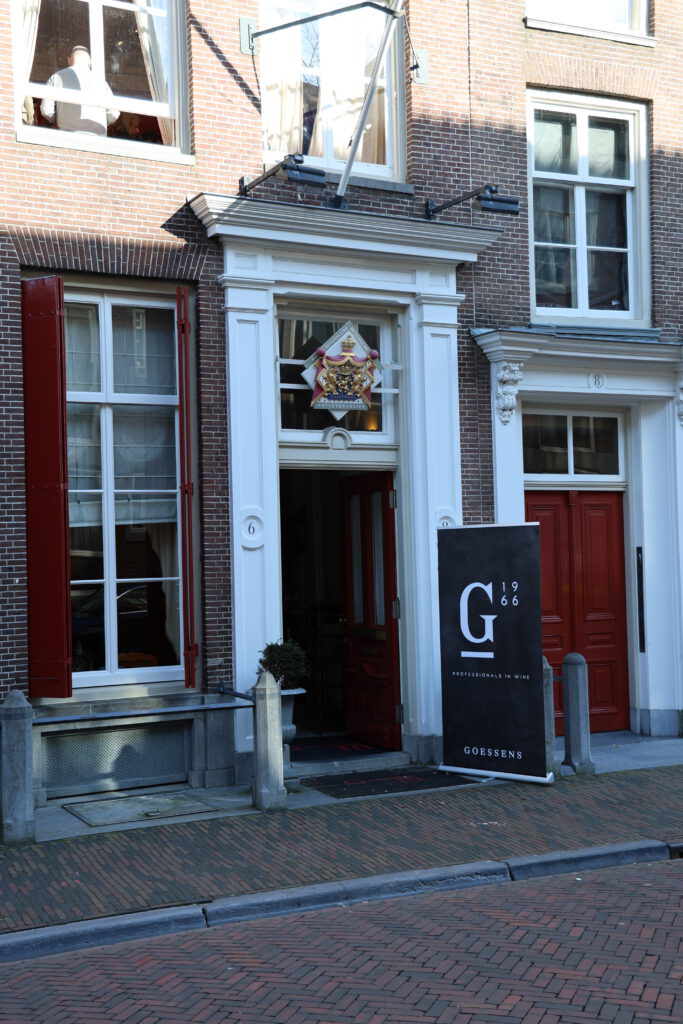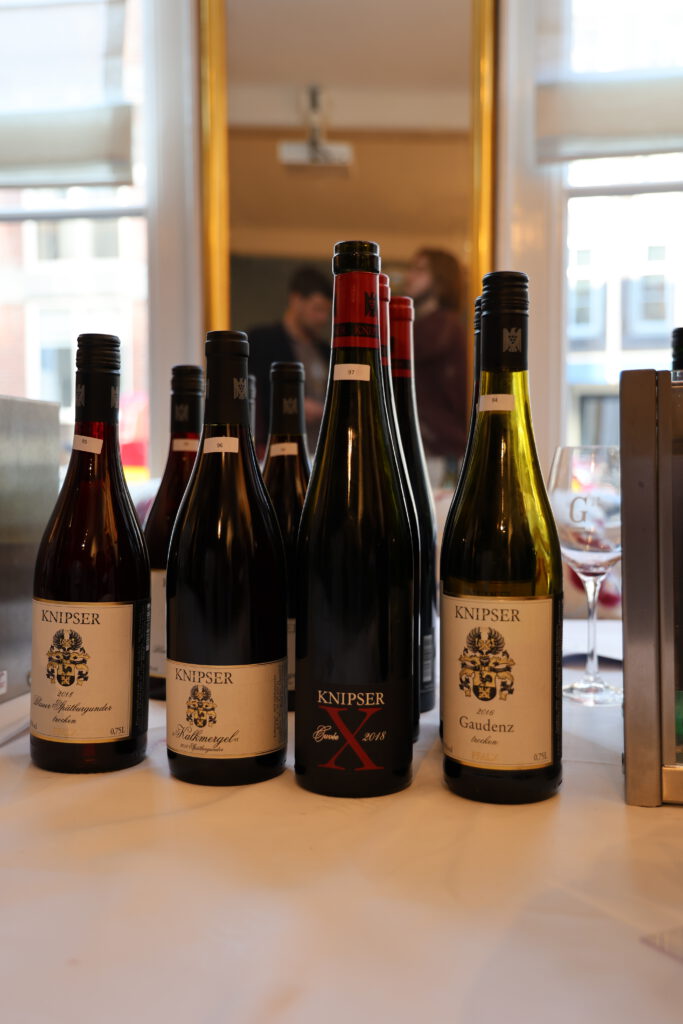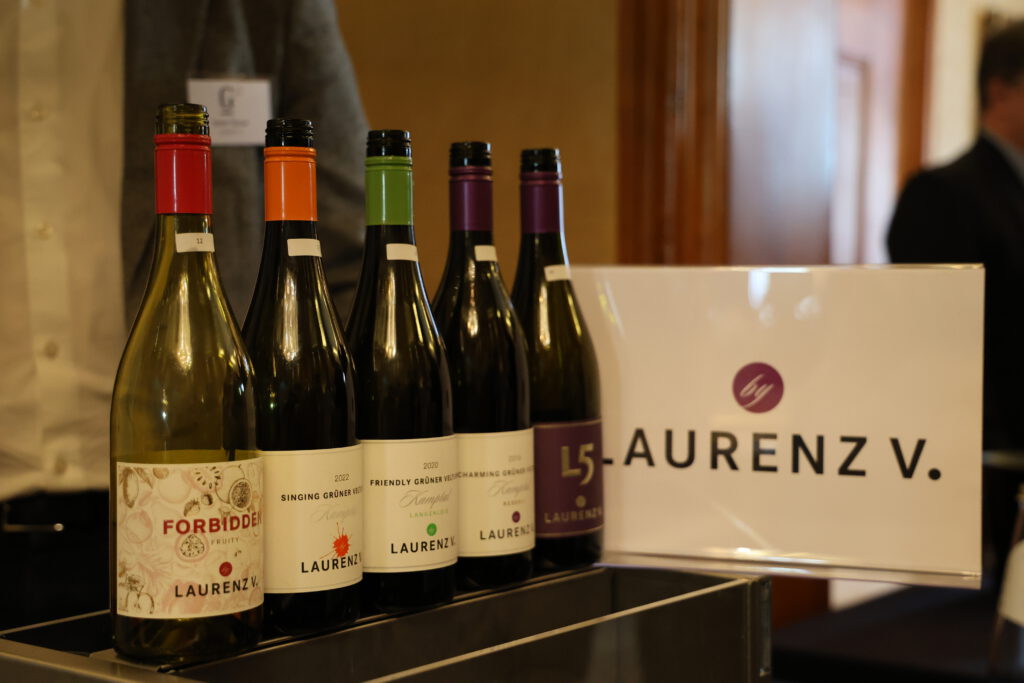Goessens – Spring Tasting 2024.
In the heart of Utrecht, and almost literally at the foot of the 112-meter-high Dom Tower, wine importer Goessens held the second of its three spring tastings of 2024 on Monday, March 4. The tasting took place in the stately ‘Huize Molenaar’ from the 18th century. Stylish, culinary, and gastronomic events have been organized at this location since 1892, which makes it the ideal place for a tasting from one of the Netherlands’ leading wine importers.
Goessens: Bridging Wineries and Wine Enthusiasts
The fact that Goessens is a major player is evident from its extensive range of more than 2,000 wines and 350 domains. Without perhaps realizing it, there’s a good chance that you have held a bottle in your hand that was imported by Goessens. They not only supply to the catering industry but are also an important partner for the wine trade, wholesale, and online sales. By organizing tastings, Goessens offers their customers the opportunity to become acquainted with the wide and varied range. The imported wineries are not only represented by the bottles present, but various winemakers are present at each tasting to present their own wines. In this way, customers are able to meet the faces behind a particular winery and listen to the winemakers’ passion and knowledge.

Overview of the Tasting
For the tasting in ‘Huize Molenaar’ a specific selection of approximately 250 wines was made and divided, by country, among the many rooms in the building. The rooms, which have largely retained their authentic interiors, immediately provide a special experience that made us walk around from room to room with amusement. It was a beautiful day with mainly good wines, and we have listed a number of them from Weingut Knipser and Laurenz V.
Weingut Knipser
Upon entering, we immediately encountered Tom Benns, the representative of Weingut Knipser from Laumersheim in the Pfalz. The Knipser winery is a purely family business and has been passed down from generation to generation over the years. This goes back to 1876 when the family moved to the village of Laumersheim and ran a mixed farming business. In 1970, the entire focus was shifted to wine growing, after which the company slowly grew into a strong wine company that operates with both feet on the ground. The culmination of this hard work came in 1993 when Knipser became a member of the Verband Deutscher Prädikatsweingüter, which showed that Knipser belongs to the absolute top in Germany.
At the helm of the current generation of Knipser are brothers Volker and Werner. Their focus is not on current trends but on making wine that they appreciate. They have succeeded well because both their red Spätburgunder and their white Riesling are highly regarded. By keeping the harvest yield per hectare low and staying away from large volumes, Knipser succeeds in letting the pure terroir shine through in their wines.

Laumersheim, Johannishof Riesling Trocken 2022
The first wine poured for us by Tom Benns. Tom said while pouring our glass, “The ideal wine for a weekday evening, but especially with nice weather in the sun.” We had no choice but to agree with him. This ‘Gutswein’ has beautiful Riesling fruit, citrus, grapefruit, fresh, good acidity, and a wonderful juiciness. Due to the 5.1 g/l residual sugar, this glass is dangerously easy to drink without noticing.
We reward this dry Riesling with a 86-point DWA score.
Laumersheim Riesling Kabinett 2021
Kabinett is known for its low alcohol percentage and generally light residual sweetness; residual sweetness in Kabinett is even mandatory within the VDP. With its 8.5% alcohol, this Kabinett is a very friendly and digestible glass. On the nose, peach, lime, mandarin, slightly sweet. Pleasant fruit acidity, juicy with a little residual sweetness.
We reward this Kabinett Riesling with a 87-point DWA score.
Laumersheim Marsannier Trocken 2018
When we think of Marsanne and Viognier, we immediately think of Rhone, but Knipser also manages to surprise with this grape blend in the Pfalz. The Marsannier was born as an experiment in 2014 and has now become an indispensable part of the range. Due to the southern exposure, these exotic grapes ripen perfectly and are picked by hand at the right ripeness. Both fermentation and maturation take place in oak barrels from Burgundy. A special glass from a special maker: ripe apple, apricot, peach, and subtle wood. Creamy but with a pleasant freshness.
We reward this white blend with a 90-point DWA score.
Laumersheim Grosses Gewächs, Steinbuckel Riesling 2021
The special thing about the Steinbuckel Grosses Gewächs is the location of this south-facing vineyard. It is located next to an old limestone quarry, and the link with top Riesling is quickly made. A wine with green fruit, citrus, something spicy but also slightly closed. In the mouth, tight, minerally, beautiful acidity, and length. Lots of potential, needs at least a few years to show itself.
We reward this single vineyard Riesling with a 93-point DWA score.
Laumersheim, Kalkmergel Spätburgunder 2018
The Pfalz is known for its all-roundness but also for its good Spätburgunder, or Pinot Noir. The vineyards are located at an altitude of approximately 130 meters on the Grosskarlbacher Burgweg, two kilometers from Laumersheim. A top vineyard with a lower average temperature than neighboring Kirschgarten. This ensures slightly fresher and more elegant wines. The name of this wine already reveals the substrate on which this Spätburgunder is planted: lime marl. Aged for 16 months in new and used wood.
Beautiful ripe fruit on the nose, cherries, raspberries, some laurel, and espresso. Full, structured, elegant, and with good length.
We reward this Spätburgunder with a 91-point DWA score.
Laumersheim, Cuvee X 2018
The name may already suggest it, but Cuvee X is, just like the Marsannier, a special cuvee. Not Spätburgunder, but a blend of Cabernet Sauvignon, Merlot, and Cabernet Franc in Médoc-style. This wine is subject to strict harvest selection by hand, completely destemmed, and aged for 24 months in new French oak. A wine with character and structure. Due to the wood aging, it has strong aromas of tobacco, leather, and cigar box. A spicy start with blackcurrant fruit, some espresso, good tannin, and length.
We reward this red blend with a 93-point DWA score.

Laurenz V.
A special winery from Kamptal DAC, Austria. Not because Laurenz V. grows Austria’s most famous grape, Grüner Veltliner, but because they grow nothing other than this national pride and have done so for five generations. The focus is entirely on this grape, from wine with a little residual sweetness, fresh and pure, to wood-aged and full. Laurenz V.’s mission is to make Grüner Veltliner one of the top premium white wines in the world. The fact that they are working hard on this is evident from the 42 countries to which they export.
At the Goessens tasting, we spoke with representative Jason Turner about the line-up of Laurenz V, which is pronounced Laurenz Five. The V refers directly to the house’s range. It consists of five different wines, all with their own appropriate names: ‘Forbidden’, ‘Singing’, ‘Friendly’, ‘Charming’, and ‘L5’. We tasted all five and will take you through our tasting experience with each wine.

Forbidden Grüner Veltliner – 2021
The name already reveals something about this wine. When you think of Grüner, you quickly think of crisp, fresh, and sparklingly pure wines. This wine that we received in the glass owes its name to the little residual sweetness that the wine has retained, and therefore only 11% alcohol. The fruit comes from gravel soils in Kamptal and Kremstal. The nights in Kamptal are generally cool, which allows the Grüner Veltliner to retain its fruity character even in warmer years. After fermentation, the wine remains on the lees a little longer for more elegance and a longer lifespan. The wine has ripe fruit, apple and pear on the nose. Tropical fruit in the mouth, juicy, citrus, slightly sweet but still sufficiently acidic.
We reward this Grüner Veltliner with a 85-point DWA score.
Singing Grüner Veltliner – 2022
The winery’s first dry Grüner, 50% of whose fruit comes from Kamptal and the other 50% from Kremstal. The ‘Singing’ is a pleasantly drinkable glass with (only) 12% alcohol and ideal for summer days on the terrace. In the glass, aromas of pear, citrus, and green apple. We immediately recognized from this wine that we had a Grüner in the glass because of that typical pepper and spiciness. Lots of fruit, juice, and crisp acidity.
We reward this Grüner Veltliner with a 86-point DWA score.
Friendly Grüner Veltliner – 2020
For the ‘Friendly’, the grapes come from the Langenlois appellation in Kamptal and fall under the so-called ‘Ortswein’, the ‘village’ Langenlois is also mentioned on the label. Langenlois is seen as the heart of the Kamptal. A wine from a step higher, beautiful fruit in the nose, apple, that striking spiciness is beautifully expressed in this wine. Very juicy, good acidity, and striking minerality.
We reward this Grüner Veltliner with a 87-point DWA score.
Charming Grüner Veltliner – 2019
This Kamptal Reserve Grüner Veltliner comes from several small vineyards in the Kamptal Valley. In contrast to the previous wines, this wine has more body and slightly more alcohol at 13%. The wine matures on the lees for between 8 and 12 months, after which the wine is bottled. We were impressed with this glass: ripe pear, citrus, lime zest, and a little bit of honey. Creamy but refreshing with good minerality. Remains in the mouth for a long time.
We reward this Grüner Veltliner with a 90-point DWA score.
L5 Grüner Veltliner – 2017
When we asked Jason Turner if we could take a photo of him, he immediately said that he wanted to do this with his favorite wine, the L5. In the glass, you would immediately think of a Burgundy-style wine. That is correct, but for this wine, we did not use Chardonnay but Grüner Veltliner. The grapes that are hand-picked from the oldest vines ripen for 18 months in French oak. A nose of pineapple, ripe pear, cinnamon sticks, and vanilla. Round mouthfeel, a small spicy edge, sufficient acidity, and length.
We reward this Grüner Veltliner with a 94-point DWA score.
Spring Tasting 2024: A Toast to Goessens’ Excellence
In addition to the Laurenz V and Knipser wineries, Goessens had a large number of wines open. For example, we tasted Meursault ‘Sous la Velle’ from Domaine Michelot, Condrieu ‘La Doriane’ from E. Guigal, and Fixin from Domaine Chevigny-Rousseau, among much more. All beautiful wines and too many to elaborate on in this article.
With the spring tasting, Goessens has once again proven to be at the forefront, as an importer but especially in its relationship and contact with its customers. A warm welcome, beautiful location, delicious dishes in between, and above all, a well-organized tasting.
This article is written by Daan (mijn.wijn.hobby). We would like to thank Goessens for their invitation and the wineries present for their time and passionate stories.
All wines discussed are imported in the Netherlands by Goessens, and available through selected retail and hospitality partners

